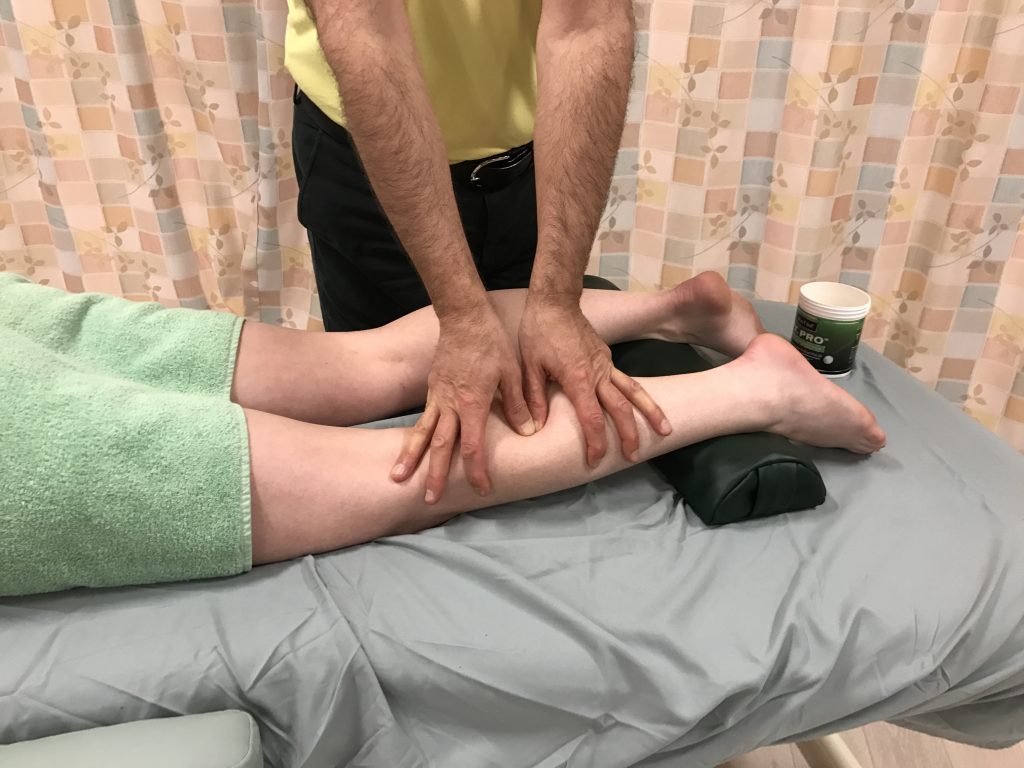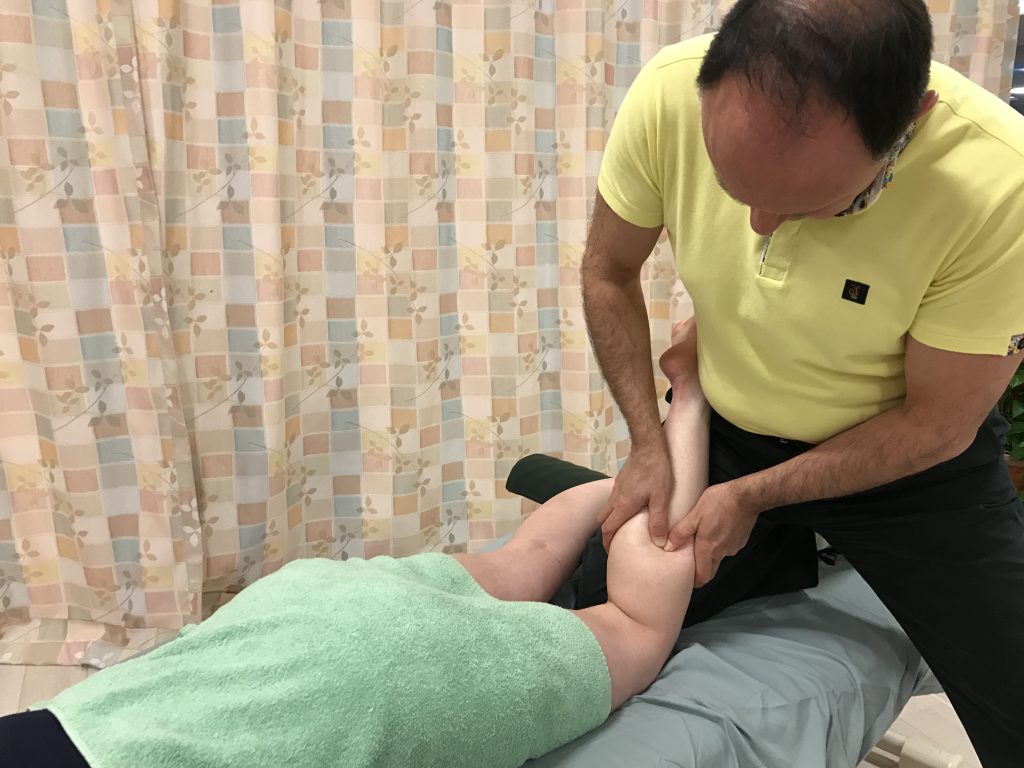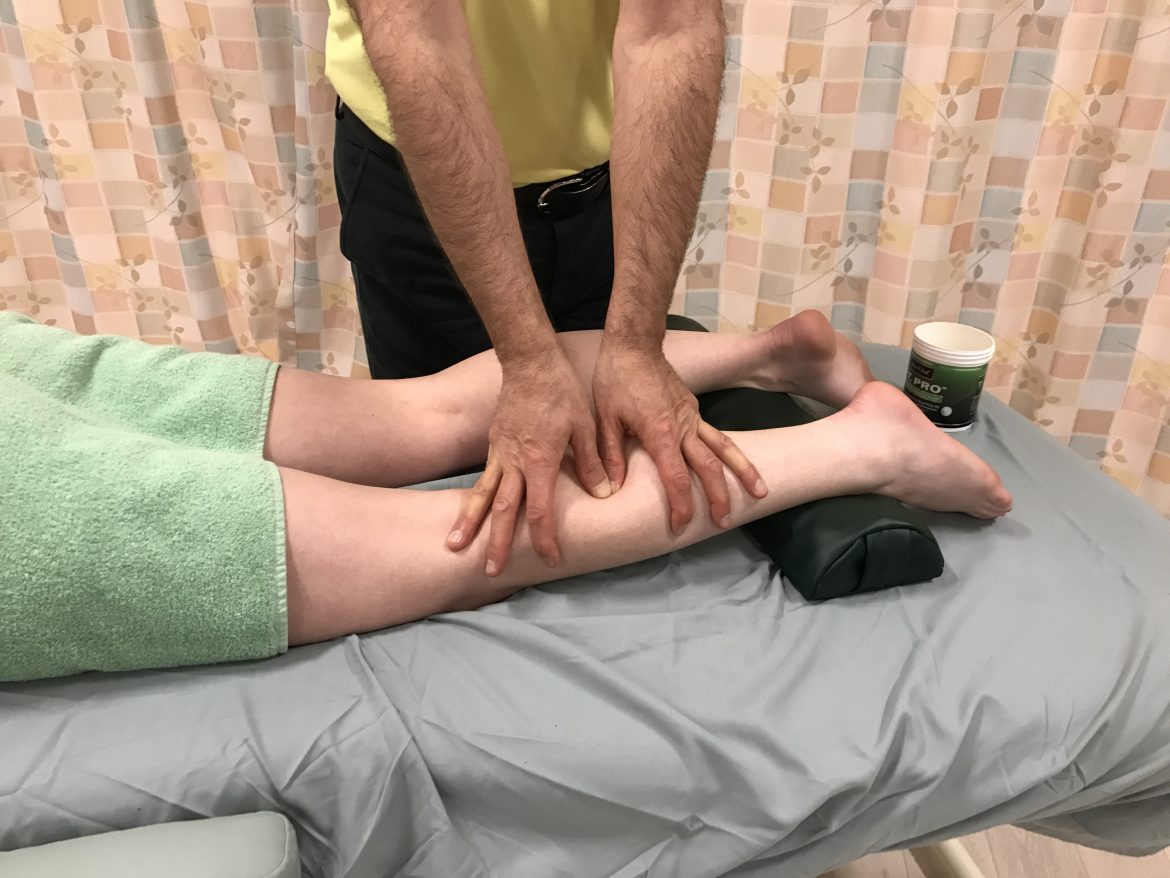Massage therapy can increase the regrowth of muscle tissue after an injury, even on the opposite, non-massaged limb.
In other words, massage therapy has been shown to have a cross-over effect for the other side of the body.
Benefits of Massage Therapy

Permission Joseph E. Muscolino. www.learnmuscles.com
Massage therapy has multiple health benefits, some long-understood and some recently claimed. Among the benefits recently asserted for massage therapy is the hypothesis that it can enhance muscle size in injured individuals who are unable to perform resistance exercise for that part of their body. Early research has shown that massage of facial muscles does indeed decrease atrophy and increases the tone of masticatory muscles. It has also been shown that massaged muscles in a denervated cat were heavier and stronger (hopefully this kind of research is not being done anymore).
Recent Study
A recent research study from Colorado State University and the University of Kentucky published in The Journal of Physiology hypothesized that the mechanical activity associated with massage therapy induces an anabolic (growth) effect in skeletal muscle undergoing regrowth after a period of atrophy.
The experiment used Brown Norway rats at 10 months of age, where they were randomly assigned into four groups (n=8 each group):
• Group 1: weight bearing (control group with no muscle atrophy)
• Group 2: hind limb suspended for 14 days (immobilization for 14 days led to atrophy)
• Group 3: hind limb suspended for 14 days followed by recovery for 7 days (similar to group 2 but this group was then allowed to weight bear and move for a recovery period of 7 days)
• Group 4: hind limb suspended for 14 days followed by recovery for 7 days of weight bearing and movement supplemented with massage as a 30-minute cyclic compressive loading applied using a special device to the right gastrocnemius every other day for 4 rounds of treatment.

Permission Joseph E. Muscolino. www.learnmuscles.com
Results
- The outcomes show that the average muscle fibre of gastrocnemius in Group 2 was decreased by 38% in response to immobilization for 14 days (compared to group 1).
- And seven (7) days of recovery in which the members of Group 3 were allowed to weight bear and move did not induce a significant regrowth response (compared to the members of Group 2).
- But muscle fibre cross-sectional area in the members of Group 4 was enhanced by 18% with massage therapy performed during the 7-day recovery period, compared to 7-day recovery period without massage (group 3).
(Note: The members of group 4 showed also showed elevated myofibrillar and cytosolic protein as well as DNA synthesis. Focal adhesion kinase [FAK] phosphorylation indicated that massage increased mechanical stimulation; while a higher number of Pax7+ cells likely explains the elevated DNA synthesis.)
The surprising outcome is that the contralateral, non-massaged, limb in the members of Group 4 exhibited a comparable 17% higher muscle fibre size compared to the members of Group 3 that were simply allowed to recover for 7 days with weight bearing and movement!
(Note: In addition, the contralateral muscle also exhibited increased myofibrillar protein synthesis, but not DNA synthesis).
Results Summarized by Group
Group 1: healthy control group – no atrophy
Group 2: immobilized for 14 days – 38% atrophy
Group 3: immobilized and then weight bearing – no significant improvement over Group 4.
Group 4: immobilized then weight bearing with massage therapy – 18% improvement on massage limb AND 17% improvement on contralateral non-massage limb
Proposed Mechanism
The authors hypothesized that massage acts through the activation of the sympathetic nervous system to cause the anabolic cross-over effect through direct neural mechanisms as well as endocrine-like processes. Alternatively, massage can cause the release of factors from muscle (such as myokines) that can influence muscles or other organs at distant sites.

Permission Joseph E. Muscolino. www.learnmuscles.com
Conclusion
The authors conclude that massage in the form of cyclic compressive loading induces an anabolic response in muscles regrowing after a period of inactivity. Muscle loss can be rapid during periods of immobilization, such as during bed rest, and it is extremely difficult to grow back, especially in older people, therefore this finding is extremely valuable. This study proves that massage as an intervention that can aid in the regrowth of muscle loss, even on the non-massaged contralateral side of the body.
This is extremely interesting because recent research studies have shown that strength training can have a cross-over effect for the “other” side of the body that was not trained. And that stretching can have a cross-over effect for the side of the body that was not stretched. Now we have evidence-based research that shows that massage therapy also has a cross-over effect for musculature on the other non-massaged side of the body.
Implications
The implications of this study are particularly remarkable because it is generally thought that massage therapy primarily works to make taut soft tissues more flexible, not stronger. But increasing the cross-sectional area of musculature increases muscle strength. Therefore, another evidence-based benefit that can now be claimed for massage is strengthening musculature, both on the side that is massage as well as on the other, non-massaged side of the body!
Applications
The applications for this are tremendous!
Massage therapists can perform beneficial treatment for many populations of clients/patients to increase muscle growth after atrophy. And given that the likely underlying mechanism is the stimulation of neural and possibly hormonal pathways, it is a reasonable extrapolation to assert that manual/massage therapy could also proactively prevent muscle loss (sarcopenia) in sedentary and elderly people.
Following are some of the populations for which massage therapy could be beneficial for muscle growth.
• post-injury
• post-illness
• post-surgery
• sedentary individuals
• injured and healthy athletes
• senior citizens to prevent muscle loss associated with aging (sarcopenia).
Note: This blog post article was created in collaboration with www.TerraRosa.com.au.
(Click here for a blog post article on The Cross-Over Effect of Stretching.)


